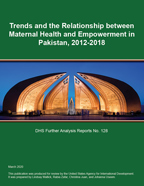
Abstract:
Background: Access to and receipt of high-
quality care during pregnancy and childbirth
is critical for preventing maternal
mortality. In male-dominated societies,
women’s lack of autonomy can be a barrier to
accessing maternal health care. However,
research often defines autonomy narrowly,
although multiple components of empowerment
may play a role. Our study assessed the
relationship between maternal health care-
seeking and measures of empowerment among
women in Pakistan in order to identify
persistent disparities in the utilization of
maternal health services.
Methods: We analyzed data from currently
married women with a recent live birth who
were interviewed in Demographic and Health
Surveys conducted in Pakistan in 2012-13 and
2017-18. We examined trends in antenatal
care, skilled birth attendance, postnatal
care, and a composite indicator of all three.
We also assessed trends in empowerment using
the validated, survey-based Women’s
emPowERment (SWPER) index, which included
three domains: attitude to violence, social
independence, and decision making. We
included an additional empowerment measure
based on women’s report of problems accessing
care. We conducted tests of association to
examine the significance of the differences
in care-seeking between survey years, and by
levels of empowerment and background
characteristics. Finally, we fitted adjusted
logistic regression models to identify the
magnitude of these associations after
controlling for key sociodemographic
characteristics.
Results: The results showed the social
independence and decision-making domains of
empowerment were each significantly and
positively associated with maternal health
care-seeking. However, the strength and
magnitude of the relationship between wealth
and care-seeking was greater than
empowerment, with a nearly 15-fold increase
in the odds of receiving all three maternal
health care contacts if a woman was in the
wealthiest quintile compared with the lowest
wealth quintile. In addition, earlier
maternal health care-seeking was associated
with increased odds of skilled attendance at
birth and postnatal care.
Conclusions: Although higher empowerment is
independently related to increased maternal
health care-seeking, wealth was a stronger
determinant. Because empowerment may also
work through wealth, stakeholders should
consider evidence of “pro-poor” policies, in
tandem with efforts towards empowerment, to
encourage timely use of services during
pregnancy and childbirth.
 Trends and the Relationship between Maternal Health and Empowerment in Pakistan, 2012-2018 (PDF, 1400K)
Trends and the Relationship between Maternal Health and Empowerment in Pakistan, 2012-2018 (PDF, 1400K)
